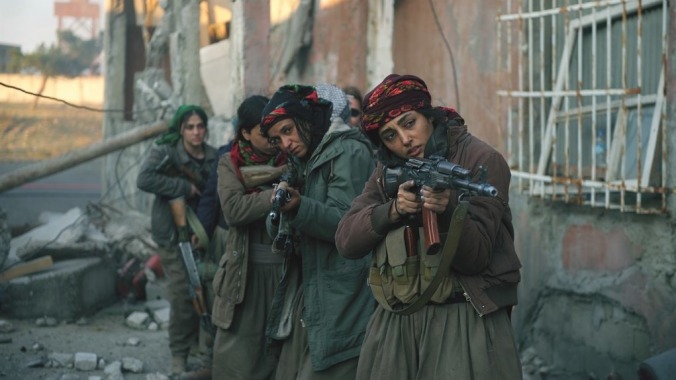A group of women share a home. Brightly colored tapestries and bedding cover the floor so they can sleep side by side. They keep a bird and a dog as pets. They braid each other’s hair. They sing songs to which everyone knows the words. The vibe is one of female sorority, and even factoring in all the guns the women are cleaning, the hand grenades they carry, and the lyrics they recite (“Our bodies and our blood / Will feed the land / Our children’s children / Our milk will be red from our death”), the atmosphere of sisterhood doesn’t change. Girls Of The Sun prioritizes that feeling of female unity against male oppression, a through-line that alternately limits and expands its narrative.
But Husson’s focus isn’t on recreating certain battles or directly linking ethnic context to these women’s identities. Girls Of The Sun shares that they were abused, raped, and bought and sold, but not why the Kurdish resistance movement—a decades-long fight by the Kurdish people for their own independent nation in the Middle East—would speak to them so deeply. Nor does she touch upon the historical reality that women have served in the peshmerga for years. Without those additional details, Girls Of The Sun tells an effective story about women reclaiming their lives from their torturers, but one that exists in a cultural vacuum.
Girls Of The Sun centers two women. The Western surrogate is journalist Mathilde (fellow filmmaker Emmanuelle Bercot), clearly styled with an eye patch after the late Marie Colvin, who died in 2012 covering the Syrian Civil War and was the subject of her own movie, A Private War, starring Rosamund Pike as Colvin. The Kurdish focal point, meanwhile, is Bahar (Golshifteh Farahani), the leader of a battalion of female peshmerga fighters. When Mathilde arrives in the conflict zone after being stuck for three months at the Turkish border, all the other journalists are leaving. She’s still grieving the recent death of her husband, and has left her young daughter with her mother. “I’m hooked on lost causes,” Mathilde sardonically says, but her cynicism is countered by the weary determination exhibited by Bahar.
In a brightly colored headscarf, with a gun strapped on her back and dirt and soot all over her face, Bahar commands fierce loyalty from her unit and begrudging respect from the male soldiers with whom the women are working. Bahar is prone to saying things like, “Dying’s the last of my fears. There’s no strategic gain,” and her plan—which the men doubt the women can pull off—is to take a certain hill as a way to gain entry to a nearby city, where a school houses young boys the Islamic State is brainwashing. Liberate the boys, liberate the town, Bahar believes.
Husson tells Bahar’s story by smoothly transitioning among various timelines. The film begins in the aftermath of a climactic attack, then flashes backs to her meeting with Mathilde; uses the tattooed names of her husband and her son on her left hand to transport us further back to her life as a happily married lawyer; jumps forward to the night when ISIS invaded her village and took her and her younger sister hostage; and then moves incrementally ahead again to her sale to various men and then to her eventual escape and enlistment. It’s a lot of narrative to cover, and although Girls Of The Sun includes jarringly violent moments (bodies lying in pools of blood, mine explosions), the film doesn’t veer into exploitation. The possibilities of sexual abuse and murder are omnipresent, but Husson maintains focus not on the ISIS fighters making the threats but on the women’s reactions, on how Bahar gathers the women together, first while they’re captured and then as they progress in battle. And Farahani is as magnetic here as she was in Marjane Satrapi’s Chicken With Plums or Jim Jarmusch’s Paterson, convincingly portraying a woman whose loss of family transforms her into an inspirational figure of vengeance.
Husson and cinematographer Mattias Troelstrup capture the scattershot nature of the war—switching between Mathilde and Bahar’s perspectives as they gaze from their enclave out into the gorgeous, treacherous surroundings, locking in tight on the women as they march into gunfights and tiptoe their way through an abandoned city. (A late-film sequence inside the pitch-black tunnels that snake underneath the town and are riddled with buried mines ratchets the tension up considerably, evoking a similarly treacherous scene in Denis Villeneuve’s Sicario.) But without a sustained emphasis on the cultural factors that shaped these women, Girls Of The Sun ultimately falls a little short. That’s not to say that Husson should have crafted a film that went deep into the differences between the Yazidis, a minority religious and ethnic group, and the Muslim Kurds. And she didn’t need to examine every element of the Islamic State’s military strategy or offer a thorough history of the peshmerga—there are documentaries to do all that. But without a more clearly defined cultural basis for its characters’ actions, Girls Of The Sun is a story about sisterhood that doesn’t provide its women the detail they deserve.


